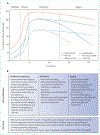Pathogenesis of chronic obstructive pulmonary disease: understanding the contributions of gene-environment interactions across the lifespan
- PMID: 35427533
- PMCID: PMC11428195
- DOI: 10.1016/S2213-2600(21)00555-5
Pathogenesis of chronic obstructive pulmonary disease: understanding the contributions of gene-environment interactions across the lifespan
Abstract
The traditional view of chronic obstructive pulmonary disease (COPD) as a self-inflicted disease caused by tobacco smoking in genetically susceptible individuals has been challenged by recent research findings. COPD can instead be understood as the potential end result of the accumulation of gene-environment interactions encountered by an individual over the life course. Integration of a time axis in pathogenic models of COPD is necessary because the biological responses to and clinical consequences of different exposures might vary according to both the age of an individual at which a given gene-environment interaction occurs and the cumulative history of previous gene-environment interactions. Future research should aim to understand the effects of dynamic interactions between genes (G) and the environment (E) by integrating information from basic omics (eg, genomics, epigenomics, proteomics) and clinical omics (eg, phenomics, physiomics, radiomics) with exposures (the exposome) over time (T)-an approach that we refer to as GETomics. In the context of this approach, we argue that COPD should be viewed not as a single disease, but as a clinical syndrome characterised by a recognisable pattern of chronic symptoms and structural or functional impairments due to gene-environment interactions across the lifespan that influence normal lung development and ageing.
Copyright © 2022 Elsevier Ltd. All rights reserved.
Conflict of interest statement
Declaration of interests AA has received research funds and honoraria as a speaker and consultant from AstraZeneca, GlaxoSmithKline, Chiesi, and Menarini for initiatives related to chronic obstructive pulmonary disease (COPD), outside of the submitted work. EM has received advisory board reimbursements and fees as a speaker from AstraZeneca, Chiesi, Novartis, and Sanofi, outside of the submitted work. DLD has received research funds from the National Institutes of Health, Alpha-1 Foundation, and Bayer, and honoraria from Novartis. RB-K has received honoraria as a speaker from AstraZeneca, GlaxoSmithKline, Menarini, and Novartis. RF has received research funds from AstraZeneca, GlaxoSmithKline, and Menarini, honoraria as a speaker from Chiesi, and consultancy fees from GlaxoSmithKline for COPD-related initiatives outside of the submitted work.
Figures



Comment in
-
GETting to know the many causes and faces of COPD.Lancet Respir Med. 2022 May;10(5):426-428. doi: 10.1016/S2213-2600(22)00049-2. Epub 2022 Apr 12. Lancet Respir Med. 2022. PMID: 35427529 No abstract available.
-
COPD, smoking, and social justice.Lancet Respir Med. 2022 May;10(5):428-430. doi: 10.1016/S2213-2600(22)00130-8. Epub 2022 Apr 12. Lancet Respir Med. 2022. PMID: 35427531 No abstract available.
Similar articles
-
When GETomics meets aging and exercise in COPD.Respir Med. 2023 Sep;216:107294. doi: 10.1016/j.rmed.2023.107294. Epub 2023 Jun 7. Respir Med. 2023. PMID: 37295536 Review.
-
Chronic obstructive pulmonary disease - diagnosis and management of stable disease; a personalized approach to care, using the treatable traits concept based on clinical phenotypes. Position paper of the Czech Pneumological and Phthisiological Society.Biomed Pap Med Fac Univ Palacky Olomouc Czech Repub. 2020 Dec;164(4):325-356. doi: 10.5507/bp.2020.056. Biomed Pap Med Fac Univ Palacky Olomouc Czech Repub. 2020. PMID: 33325455
-
Gene-environment interaction between the MMP9 C-1562T promoter variant and cigarette smoke in the pathogenesis of chronic obstructive pulmonary disease.Environ Mol Mutagen. 2016 Jul;57(6):447-54. doi: 10.1002/em.22025. Epub 2016 Jun 7. Environ Mol Mutagen. 2016. PMID: 27270564
-
Chronic Obstructive Pulmonary Disease Pathogenesis.Clin Chest Med. 2020 Sep;41(3):307-314. doi: 10.1016/j.ccm.2020.05.001. Clin Chest Med. 2020. PMID: 32800186 Review.
-
Omics and the Search for Blood Biomarkers in Chronic Obstructive Pulmonary Disease. Insights from COPDGene.Am J Respir Cell Mol Biol. 2019 Aug;61(2):143-149. doi: 10.1165/rcmb.2018-0245PS. Am J Respir Cell Mol Biol. 2019. PMID: 30874442 Free PMC article. Review.
Cited by
-
Impact of Lung-Related Polygenic Risk Scores on Chronic Obstructive Pulmonary Disease Risk and Their Interaction with w-3 Fatty Acid Intake in Middle-Aged and Elderly Individuals.Nutrients. 2023 Jul 7;15(13):3062. doi: 10.3390/nu15133062. Nutrients. 2023. PMID: 37447386 Free PMC article.
-
Dietary fibre in relation to lung function and respiratory symptoms from childhood to adulthood.ERJ Open Res. 2023 Jun 26;9(3):00036-2023. doi: 10.1183/23120541.00036-2023. eCollection 2023 May. ERJ Open Res. 2023. PMID: 37377658 Free PMC article.
-
Improved Air Quality and Asthma Incidence from School Age to Young Adulthood: A Population-based Prospective Cohort Study.Ann Am Thorac Soc. 2024 Oct;21(10):1432-1440. doi: 10.1513/AnnalsATS.202402-200OC. Ann Am Thorac Soc. 2024. PMID: 38959417 Free PMC article.
-
Mediterranean Diet and Lung Function in Adults Current Smokers: A Cross-Sectional Analysis in the MEDISTAR Project.Nutrients. 2023 Mar 3;15(5):1272. doi: 10.3390/nu15051272. Nutrients. 2023. PMID: 36904270 Free PMC article.
-
The AGE-RAGE Axis and the Pathophysiology of Multimorbidity in COPD.J Clin Med. 2023 May 9;12(10):3366. doi: 10.3390/jcm12103366. J Clin Med. 2023. PMID: 37240472 Free PMC article. Review.
References
-
- Barnes PJ. Endo-phenotyping of COPD patients. Expert Rev Respir Med 2021; 15: 27–37. - PubMed
-
- Agustí A, Hogg JC. Update on the pathogenesis of chronic obstructive pulmonary disease. N Engl J Med 2019; 381: 1248–56. - PubMed
-
- Hunter DJ. Gene–environment interactions in human diseases. Nat Rev Genet 2005; 6: 287–98. - PubMed
Publication types
MeSH terms
Grants and funding
LinkOut - more resources
Full Text Sources
Medical

